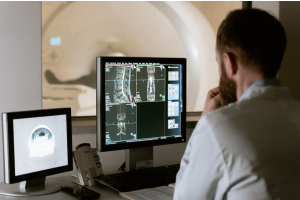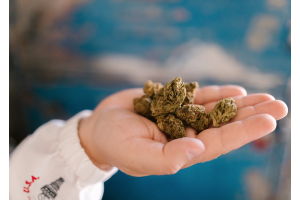Cannabis For Lyme Disease: Does It Help?

In North America and Europe, Lyme disease cases are spreading like wildfire. The Centers for Disease Control and Prevention (CDC) reports about 30,000 cases annually.
Though, they admit that number doesn't reflect the number of diagnoses, with estimates of up to 476,000 people being infected annually. ¹While there's a standardized treatment for Lyme Disease (a round of antibiotics), many struggle with symptoms even after medication, for this reason, some are looking towards natural alternatives, such as cannabis.Admittedly, there's currently no data on whether or not you can use cannabis for Lyme Disease. More specifically, there's no evidence claiming cannabis can fight against the infection itself. However, some are turning to cannabis as a therapeutic remedy to manage pain, insomnia, and headaches. This article will examine Lyme Disease and how cannabis may benefit you.
Paul's Note: As someone who struggled with Lyme Disease and used cannabis throughout my treatment, I have some personal insight I'd like to share as we continue. My experiences are not directly tied to the research discussed here and should not be taken as advice for medical treatment.
What is Lyme Disease?
During this stage, you may also experience the following symptoms:•Fever and chills•General ill feeling•Headache•Joint pain•Muscle pain•Stiff neck
Paul's Note: It's worth mentioning that not everyone will develop a "bulls-eye." While estimates aren't concrete, it's believed about 70% to 80% of patients develop this rash. ³ In my case, I did NOT develop a rash. I did not experience any symptoms during the first stage of the condition.
EARLY DISSEMINATED LYME DISEASE
Within weeks or months of the tick bite, the disease will spread throughout the body. During this time, you will enter the second stage of Lyme Disease and experience the following symptoms:
- Heart problems (i.e., skipped heartbeats, palpitations)
- Lightheadedness or fainting
- Meningitis (severe headaches, stiff neck, fever)
- Numbness or pain in the distribution of a nerve
- Paralysis or weakness in facial musclesIt's worth noting that you may also experience symptoms characterized by the first stage of Lyme Disease.Paul's Note: I initially felt symptoms during this stage, was diagnosed, and received the traditional treatment (10 days of doxycycline).
t's worth noting that you may also experience symptoms characterized by the first stage of Lyme Disease.
Paul’s Note: I initially felt symptoms during this stage, was diagnosed, and received the traditional treatment (10 days of doxycycline).
LATE DISSEMINATED LYME DISEASE
A few months or years after the initial bite, the infection will spread throughout the body and develop some concerning symptoms.The most notable is fluid accumulation in larger joints (especially the knees) that cause severe pain. You may also experience neuropathy (numbness or pain in the peripheral nerves).Alongside these unusual symptoms, you can also feel symptoms from the previous 3 stages.
How is Lyme Disease Traditionally Treated?
According to the CDC, the sooner Lyme Disease is treated, the more effective treatment will be.² In other words, if you take the recommended treatment during "Early Localized Lyme Disease," you likely won't experience the later 2 stages. This treatment involves a few weeks of antibiotics. The most common include doxycycline and amoxicillin. It's believed that this treatment is enough to rid the body of infection, no matter what stage of your condition.
However, conflicting research suggests otherwise. Some scientists believe that later stages of the condition cross the blood-brain barrier - making a short course of oral antibiotics ineffective.4Furthermore, it's been found that the bacteria which causes Lyme Disease is a spirochete that may be able to burrow itself into bone tissue - also making oral antibiotics ineffective.5With this conflicting data, some medical professionals have recommended long-term, aggressive antibiotic treatment for Lyme Disease patients. However, these recommendations are not backed up by the CDC. Namely, this is because aggressive antibiotic treatment comes with a plethora of side effects that may cause more damage to the body than Lyme Disease itself.
Paul's Note: As mentioned, I initially received the CDC-recommended 10-day antibiotic course. But since I continued to experience symptoms, I continued with aggressive antibiotics for about a year. As noted, the side effects were brutal and left me in a prolonged recovery afterward. However, after this year of treatment, I no longer felt Lyme Disease symptoms.
Can You Use Cannabis for Lyme Disease?
As mentioned, there's no evidence to suggest cannabis (or any cannabinoids) can fight the infection of Lyme Disease. Instead, some people incorporate cannabis to relieve specific symptoms caused by this condition. The following is a discussion of specific Lyme Disease symptoms and research giving insight into how cannabis may be effective in relieving these symptoms:
PAIN AND INFLAMMATION
One of the most notable symptoms of Lyme Disease is pain and inflammation - namely found in specific joint muscles (i.e., elbows and knees). There’s plenty of evidence suggesting that cannabis's psychoactive cannabinoid tetrahydrocannabinol (THC) can help to relieve pain and inflammation. A 2017 review concluded that our research is enough to prompt some healthcare providers to prescribe cannabis for pain. Namely, when first- and second-line treatment regimens are ineffective.6Cannabidiol (CBD) has also been recommended as a prominent pain reliever.7 In the case of Lyme Disease, some may prefer topical treatments as these will allow you to target specific joints where the pain is most effective.
Paul's Note: I consumed both THC-high cannabis products and CBD products throughout my Lyme Disease treatment. I preferred CBD for daytime use since it didn't leave me with psychoactive effects. However, when it came to night-time relief, I used THC and ultimately found it more effective for pain.
INSOMNIA
Poor quality sleep is often associated with Lyme Disease. One study found that about 41% of Lyme Disease patients reported having difficulty sleeping.8This is due to symptoms - such as pain - making it difficult to get a good night's rest. Therefore, the goal of cannabis isn't necessarily to induce sedation. Instead, it's to relieve symptoms enough to allow for better sleep. We’ve already talked about how cannabis can help with pain. But we haven't discussed how cannabis (both THC and CBD) may relieve stress and anxiety.9These two mental afflictions are common among Lyme Disease patients.10 On top of that, they're the leading cause of insomnia.¹¹According to research:•A 2008 study found that ingesting cannabis with high THC levels reduces the amount of REM (dream-state) sleep you receive. However, due to this inhibition, cannabis allowed the brain to enter a more "deep sleep" state, which is believed to be more restorative.¹²•On the flip side, some studies suggest regular marijuana use may impair sleep.¹³With these two pieces of research, it's difficult to determine whether or not cannabis will help your Lyme-induced insomnia. If you were a regular cannabis consumer before Lyme, chances are cannabis is already influencing your sleep (whether good or bad), and sudden quitting will result in problems. On the flip side, if you hadn't used cannabis regularly before Lyme, there's a chance marijuana will initially help with sleep. But with regular use, this aid may change.
Paul's Note: Since I was a regular marijuana consumer before Lyme Disease, it's difficult for me to determine how much cannabis helped with my insomnia. Some nights, it worked wonders; other nights, it didn't do anything. With that said, I would consider other all-natural sedators (such as ashwagandha) before using cannabis strictly for insomnia.
SEIZURES
Admittedly, it's extremely rare for Lyme Disease to cause seizures, which usually only occur in the worst cases of the condition. If these symptoms suddenly appear in your life, cannabis may be able to help. A 2018 review found cannabis may effectively reduce epilepsy in drug-resistant patients.14However, THC isn't the first recommendation for seizure control due to its psychoactive effects. Rather, CBD may be just as effective at reducing epileptic episodes while keeping patients in a non-psychoactive state.15There's been so much evidence backing this up that the Food and Drug Administration (FDA) approved the only cannabis-derived pharmaceutical (Epidiolex) for rare cases of epilepsy.16
Risk Factors for Cannabis and Lyme Disease
Admittedly, cannabis won't help everyone with Lyme Disease. You may be experiencing more problems when consuming cannabis than you had previously. The most notable of these is psych activity. Not everyone enjoys the "high" cannabis brings about. In extreme cases, it can lead to paranoia or psychosis. If you're fighting an infectious disease, such stressors aren't benefiting your condition. The more stressed you are, the weaker your immune system becomes - making it more difficult to fight infection.17Beyond psych activity, other adverse effects caused by cannabis include:18
- Confusion
- Difficulty with balance and coordination
- Dry mouth and eyes
- Increased heart rate
- Increased hunger
- Nausea and vomiting
- Problems with thinking and reasoning
- Sedation To top this off, cannabis may negatively interact with your medication to combat Lyme Disease.19
Final Word
Lyme Disease is a complicated condition that medical professionals are still investigating. Since the primary goal of treatment is to rid the body of infection, cannabis is useless to you.However, it does hold the potential to relieve specific symptoms associated with Lyme Disease - namely, pain, insomnia, and seizures.Admittedly, cannabis may cause more problems than solutions. This ultimately depends on how your body reacts to either THC or CBD.
In all cases, it's best to speak with your medical provider to determine whether or not cannabis is the right option for your treatment.
Paul's Note: My doctor was aware of my cannabis use for my Lyme Disease treatment. He encouraged me to continue to consume it since it was helping with the worst of my symptoms (pain).Furthermore, I found cannabis to help with the side effects caused by the medication. It can become difficult to eat when you're on doxycycline since the medication is destroying essential gut bacteria. Cannabis helped improve my appetite and ensure I maintained a healthy weight.Still, my notes here aren't a recommendation for cannabis in Lyme Disease patients. While cannabis certainly made the treatment process more of a breeze, it did nothing to help rid my body of the infection.
Reference Sources
1 Centers for Disease Control and Prevention (CDC): Lyme Disease: Data and surveillance: https://www.cdc.gov/lyme/datasurveillance/index.html
2 Centers for Disease Control and Prevention (CDC): Lyme Disease: https://www.cdc.gov/lyme/index.html3
Indiana State Department of Health: Lyme Disease Quick Facts: https://www.in.gov/health/erc/files/LYME-DISEASE-Quick-Facts.pdf
4 National Institute of Allergy and Infection Diseases (NIAID): Lyme Disease Antibiotic Treatment Research: https://www.niaid.nih.gov/diseases-conditions/lyme-disease-antibiotic-treatment-research
5 HHS Public Access: Biology of Infection with Borrelia burgdorferi: https://www.ncbi.nlm.nih.gov/pmc/articles/PMC2440571/
6 Cannabis and Cannabinoid Research: Cannabis and Pain: A Clinical Review: https://www.ncbi.nlm.nih.gov/pmc/articles/PMC5549367/
7 frontiers in Pharmacology: A Balanced Approach for Cannabidiol Use in Chronic Pain: https://www.ncbi.nlm.nih.gov/pmc/articles/PMC7204604/
8 Sleep: Sleep quality in well-defined Lyme disease: a clinical cohort study in Maryland: https://pubmed.ncbi.nlm.nih.gov/29452400/
9 Current Psychiatry Reports: Cannabis, Cannabinoids, and Sleep: a Review of the Literature: https://pubmed.ncbi.nlm.nih.gov/28349316/10
10 Case Reports in Psychiatry: New-Onset Panic, Depression with Suicidal Thoughts, and Somatic Symptoms in Patients with a History of Lyme Disease: https://www.ncbi.nlm.nih.gov/pmc/articles/PMC4397473/
11 HHS Public Access: Insomnia symptoms and short sleep predict anxiety and worry in response to stress exposure: a prospective cohort study of medical interns: https://www.ncbi.nlm.nih.gov/pmc/articles/PMC7045299/
12 Sleep Medicine Reviews: Effects of illicit recreational drugs upon sleep: cocaine, ecstacy and marijuana: https://pubmed.ncbi.nlm.nih.gov/18313952/
13 Journal of Addictive Diseases: Marijuana use patterns and sleep among community-based young adults: https://www.tandfonline.com/doi/full/10.1080/10550887.2015.1132986
14 Cureus: Epilepsy and Cannabis: A Literature Review: https://www.ncbi.nlm.nih.gov/pmc/articles/PMC6235654/
15 molecules (MDPI): Use of Cannabidiol in the Treatment of Epilepsy: Efficacy and Security in Clinical Trials: https://www.ncbi.nlm.nih.gov/pmc/articles/PMC6514832/
16 Food and Drug Administration (FDA): FDA Approves First Drug Comprised of an Active Ingredient Derived from Marijuana to Treat Rare, Severe Forms of Epilepsy: https://www.fda.gov/news-events/press-announcements/fda-approves-first-drug-comprised-active-ingredient-derived-marijuana-treat-rare-severe-forms
17 HHS Public Access: Psychological Stress and the Human Immune System: A Meta-Analytic of 30 Years of Inquiry: https://www.ncbi.nlm.nih.gov/pmc/articles/PMC1361287/
18 HHS Public Access: Adverse Health Effects of Marijuana Use: https://www.ncbi.nlm.nih.gov/pmc/articles/PMC4827335/
18 Department of Health (DOH): Medical Cannabis Adverse Effects & Drug Interactions: https://doh.dc.gov/sites/default/files/dc/sites/doh/publication/attachments/Medical%20Cannabis%20Adverse%20Effects%20and%20Drug%20Interactions_0.pdf
Written and Published by Paul James in Weed World Magazine issue 162
Featured Image: Pexels












Validate your login